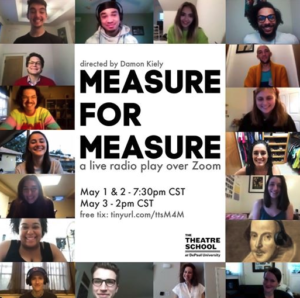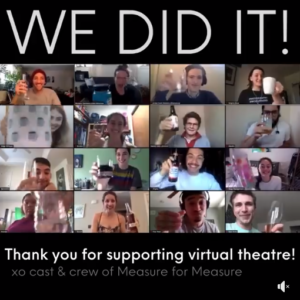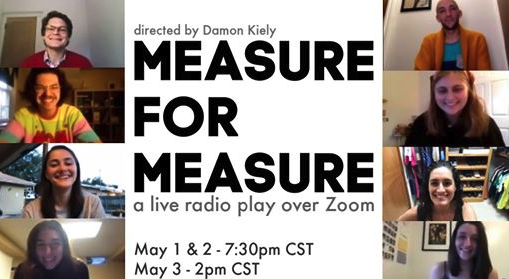Welcome to the 7th episode of “Shoots!” where I celebrate examples of 21st century entrepreneurialism emerging in unexpected places.
In this installment I share how a project can rapidly reinvent itself in response to the Covid-19 disruption and remain true to its strategic roots. You will learn how a production of Shakespeare’s Measure for Measure at Chicago’s DePaul University achieved this by:
- Defining clear success criteria and “must haves”
- Using the criteria to create an alternative plan
- Reducing scope to achieve excellence
+++++++++++++++++++++++++++++++
Broadway theaters went dark on March 12 and venues across the country rapidly followed suit. Universities shuttered in-person learning and plans for a return this fall remain murky. If you are a professor or student at a university theater program, what do you do?
As the Covid-19 reality set in, many questions emerged for Measure for Measure’s director, Damon Kiely. One of the Associate Dean of DePaul’s Theatre School urged the ten spring productions to persevere and figure out ways to perform them, despite the obvious constraints. However, beyond her high-level encouragement she did not provide specific advice or “how tos.”
Damon felt enormous responsibility. As Chair of Performance, Directing and Acting, he needed to set an example. This Measure for Measure production was conceived to be even more dependent on a live audience than most, with actors sitting with the audience observing the narrative together. He had already conducted in-person rehearsals for two weeks and designers had conceived of a set bringing together elements from 1604 and 2020. But when in-person rehearsals stopped in March everything needed to be re-imagined.
Defining Clear Success Criteria and “Must Haves”
When any initiative becomes unmoored, a clear understanding of its strategic roots is vital to regroup without losing time and damaging morale. With students and production staff scattered and in urgent need of a new plan, “We were in total disarray and in mourning,” Damon recalled.
In determining his next steps, Damon intuitively referenced three criteria that defines success for any academic play he directs:
- Do the students learn something of lasting value?
- Will the audience enjoy the experience?
- Does the production provoke the audience to re-examine an important topic?
Damon’s commitment to these criteria helped him evaluate alternatives and develop a principled, flexible and achievable plan. He developed a list of musts, which included:
- Live shows on multiple days
- Audience engagement
- Stable delivery platform
- No additional rehearsal time beyond what was scheduled pre-pandemic
In today’s uncertainty, does your organization agree on what must remain unchanged? Re-stating these principles and keeping them top of mind allows everyone to navigate towards common goals, even amidst significant upheaval.
Using the Criteria to Create an Alternative Plan
Damon evaluated a range of options. He explored Zoom – using actors in the now-familiar video conference boxes. He heard of Zoom plays where characters illuminated their video only when they were in the scene. He considered a “Zoom plus” version with actors’ frames were augmented with lighting and costumes.
Other DePaul Spring Quarter theater productions took different slightly different paths. Two utilized incredibly creative non-Zoom, pre-recorded online formats. The Model Play features female models traveling to Fashion Week showcases around the globe. Their website takes the audience through acts set in different fashion hotspots. Each character’s vintage outfit includes a clickable link to where the items were purchased online. Boxed In’s audience unpacks cardboard boxes storing objects from three different chapters of a serial killer’s childhood. Clicking each object activates narration from the killer’s parents, unveiling additional layers of the tragedy.
While these possibilities worked well for other productions, each violated one or more of Damon’s must-have criteria for Measure for Measure:
|
Strategic Option |
Issue(s) |
| Zoom | Less stable with large audiences
Potential for disruption (e.g., unmuting) |
| “Zoom plus” | Required additional rehearsal time |
| Pre-recorded | Not live, no repeat performances
No immediate audience interaction |
Instead, Damon opted for a 21st century version of a 1930’s and 40’s staple, a live radio play through Zoom on three consecutive days in early May, each followed by an audience feedback session. This format allowed students to experience the professional reality of live, repeated performances and retained aspects of direct audience involvement in his original concept, albeit remotely.

Measure for Measure was performed three consecutive days from May 1-3 2020
This plan required significant compromise, many of which are unthinkable in modern theater: no video until the end of the show and no costumes or lighting. It would be impossible to include the original 17th and 21st century design elements. But these were necessary decisions, given that the cast and production staff had a month to deliver Measure for Measure live while sitting in front of computers in bedrooms across the country.
For nearly every organization, it’s clear that what worked at the beginning of 2020 must be re-examined (and likely re-done) for the current reality. Rather than creating an ad hoc action plan, your principles can help you determine which compromises are acceptable and which are not.
Reducing Scope to Achieve Excellence
Once the visual elements of acting were removed, actors soon recognized they only had their voices to work with. With that singular focus, some who were struggling with their roles elevated their delivery to professional levels in the radio format. Another actor not cast in the play realized she could contribute sound effects, using props like boards and shoes, as well as recorded audio for transitions. Another created a slide show for stage directions. The stage managers leapt in and figured out how to lead a virtual room.
While there was opportunity to further enhance the production, Damon stuck with his plan of limiting rehearsals to the number of hours originally planned. He encouraged actors to do work independently or focus on their lives beyond Measure for Measure.
The decision to use the radio play format paid dividends in unexpected ways. During one of the three performances an actor’s mother disconnected their home’s router. A stage manager immediately recognized this, jumping in to pinch-hit and reading the actor’s lines. The audio-only format prevented the audience from realizing something was amiss prior to the router being reconnected.
The actors improved so noticeably and in such a short time that Damon’s colleagues plan to dedicate a week of “radio play” rehearsal for any future Shakespeare play, allowing actors to more fully master the spoken dimension of their roles.

Measure for Measure’s cast and crew celebrates completing a production like no other.
When struggling to improve on a complex task or project, identify ways to focus on a one or two aspects at a time. As you make progress, work on other pieces and bring things together along the way.
+++++++++++++++++++++++++++++++
The Measure for Measure cast and crew overcame significant obstacles in delivering their show on three consecutive days. Damon reflected on this accomplishment through the lens of his success criteria.
- Did the students learn something of lasting value? Lessons from their 2020 Measure for Measure experience will remain indelible.
- Did the audience enjoy the experience? The feedback sessions confirmed an overwhelming, positive response to the play.
- Does the production provoke the audience to re-examine an important topic? Damon originally intended to focused on themes of abusing power and government, but he said in its new form “the play resonated in different, surprising ways – teaching me about the impossibility of making choices when you don’t know the future and everything seems out of control.”
I’d like to take this opportunity to remind everyone of the play’s themes and how little has changed in centuries. “Over 400 years ago Shakespeare had already seen into the depths of the #metoo era,” Damon remarked. “He seemed to say – ‘hey if anyone wants to know what happens when a man in power is alone in a room with a woman with no power – here you go!’”
Shakespeare’s prescience on timeless issues is one example of how important the arts are in initiating dialogue and effecting necessary change in our society. Please take a moment to think of an arts institution in your community you want to support and make a donation if you are able. It’s clear that performing arts of any type have been profoundly disrupted and they need our help be sustained until things are “normal” again. If you’re looking for suggestions, please consider the two below:
The Public Theater (Shakespeare in the Park in New York City)
Kyle Okimoto is the founder of Market Junctions, which helps transform the power of disruption into a force of positive change. He is the creator of the Resiliency Map, a process anyone can use to increase their resilience by drawing from their own experience and that of others. He is the Acting Chief Marketing Officer for Trade Exchange, a marketplace for investment ideas and an investor and advisor in startups ranging from Cadence (high yield short term alternative investments), AltoIRA (self-directed retirement accounts for alternative investments), ARIS Technology (robotic quality control laser scanning).


